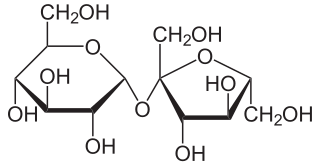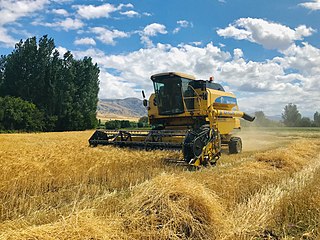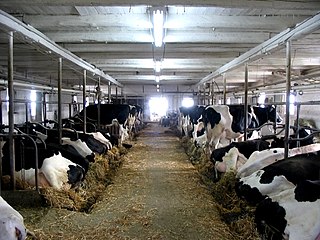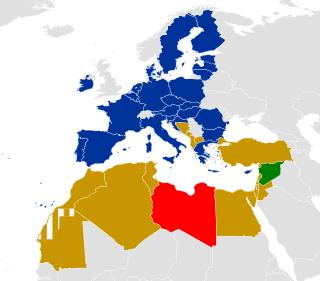Related Research Articles
The economy of Eswatini is fairly diversified. Agriculture, forestry and mining account for about 13 percent of Eswatini's GDP whereas manufacturing represent 37 percent of GDP. Services – with government services in the lead – constitute the other 50 percent of GDP.

Sucrose, a disaccharide, is a sugar composed of glucose and fructose subunits. It is produced naturally in plants and is the main constituent of white sugar. It has the molecular formula C
12H
22O
11.

The economy of Austria is a developed social market economy, with the country being one of the fourteen richest in the world in terms of GDP per capita. Until the 1980s, many of Austria's largest industry firms were nationalised. In recent years, privatisation has reduced state holdings to a level comparable to other European economies.

The Common Agricultural Policy (CAP) is the agricultural policy of the European Union. It implements a system of agricultural subsidies and other programmes. It was introduced in 1962 and has since then undergone several changes to reduce the EEC budget cost and consider rural development in its aims. It has however, been criticised on the grounds of its cost, its environmental, and humanitarian effects.

Agricultural policy describes a set of laws relating to domestic agriculture and imports of foreign agricultural products. Governments usually implement agricultural policies with the goal of achieving a specific outcome in the domestic agricultural product markets.

An agricultural subsidy is a government incentive paid to agribusinesses, agricultural organizations and farms to supplement their income, manage the supply of agricultural commodities, and influence the cost and supply of such commodities.
The Lomé Convention is a trade and aid agreement between the European Economic Community (EEC) and 71 African, Caribbean, and Pacific (ACP) countries, first signed in February 1975 in Lomé, Togo.
Trade can be a key factor in economic development. The prudent use of trade can boost a country's development and create absolute gains for the trading partners involved. Trade has been touted as an important tool in the path to development by prominent economists. However trade may not be a panacea for development as important questions surrounding how free trade really is and the harm trade can cause domestic infant industries to come into play.

High-fructose corn syrup (HFCS), also known as glucose–fructose, isoglucose and glucose–fructose syrup, is a sweetener made from corn starch. As in the production of conventional corn syrup, the starch is broken down into glucose by enzymes. To make HFCS, the corn syrup is further processed by D-xylose isomerase to convert some of its glucose into fructose. HFCS was first marketed in the early 1970s by the Clinton Corn Processing Company, together with the Japanese Agency of Industrial Science and Technology, where the enzyme was discovered in 1965.
The Agreement on Agriculture (AoA) is an international treaty of the World Trade Organization. It was negotiated during the Uruguay Round of the General Agreement on Tariffs and Trade, and entered into force with the establishment of the WTO on January 1, 1995.

Agriculture is one of the dominant parts of Senegal's economy, even though Senegal lies within the drought-prone Sahel region. As only about 5% of the land is irrigated, Senegal continues to rely on rain-fed agriculture. Agriculture occupies about 75% of the workforce. Despite a relatively wide variety of agricultural production, the majority of farmers produce for subsistence needs. Millet, rice, corn, and sorghum are the primary food crops grown in Senegal. Production is subject to drought and threats of pests such as locusts, birds, fruit flies, and white flies. Moreover, the effects of climate change in Senegal are expected to severely harm the agricultural economy due to extreme weather such as drought, as well as increased temperatures.

Agriculture is still an important sector of Turkey's economy, and the country is one of the world's top ten agricultural producers. Wheat, sugar beet, milk, poultry, cotton, vegetables and fruit are major products; and Turkey is the world's largest grower of hazelnuts, apricots, and oregano.

Agriculture in Guyana is dominated by sugar and rice production. Although once the chief industry, it has been overshadowed by mining.

The Guyana Sugar Corporation, or GuySuCo, is a Guyanese sugar company owned by the government. It is the country's largest cultivator and producer of sugar, a historically important commodity in the country. They produce Demerara Sugar for export around the world.

Moldova is an agrarian-industrial state, with agricultural land occupying 2,499,000 hectares in a total area of 3,384,600 hectares. It is estimated that 1,810,500 of these hectares are arable. Moldova is located in Eastern Europe, and is landlocked, bordering Romania and Ukraine. Moldova's agricultural sector benefits from a geographical proximity to large markets, namely the European Union. As a share of GDP, agriculture has declined from 56% in 1995 to 13.8% in 2013. Data from 2015 estimated that agriculture accounted for 12% of Moldova's GDP. Agriculture as a sector is export-oriented, with the composition of Moldova's total exports containing agriculture and the agri-food sector as a main component. 70% of agri-food exports in 2012 included beverages, edible fruits and nuts, oilseeds, vegetable preparations and cereals. Here, fruits, vegetables and nuts were attributed to 33% of Moldova's exports for 2011–2013. Moldova is also one of the top ten apple exporters in the world. However, because of the long-term emphasis on fruit, vegetables are often imported.
The Jones-Costigan Amendment, also known as the Sugar Act of 1934, passed on May 9, 1934 was an amendment to the Agricultural Adjustment Act that reclassified sugar crop as basic commodity, subject to the provisions of the Agricultural Adjustment Act enacted the previous year. Sponsored by Senator Edward P. Costigan (D-CO) and Representative John Marvin Jones (D-TX), the act was a New Deal effort to salvage an ailing sugar industry by imposing protective tariffs and quotas along with a direct subsidy to growers of sugar cane and sugar beet.

Canada's supply management, abbreviated SM, is a national agricultural policy framework used across the country, which controls the supply of dairy, poultry and eggs through production and import controls and pricing mechanisms. The supply management system was authorized by the 1972 Farm Products Agencies Act, which established the two national agencies that oversee the system. The Agriculture and Agri-Food Canada federal department is responsible for both the Canadian Dairy Commission and its analogue for eggs, chicken and turkey products, the Farm Products Council of Canada. Five national supply management organizations, the SM-5 Organizations — Egg Farmers of Canada (EFC), Turkey Farmers of Canada (TFC), Chicken Farmers of Canada (CFC), the Canadian Hatching Egg Producers (CHEP) and the Ottawa-based Canadian Dairy Commission (CDC), a Crown corporation — in collaboration with provincial and national governing agencies, organizations and committees, administer the supply management system.

Eurafrica refers to the originally German idea of strategic partnership between Africa and Europe. In the decades before World War II, German supporters of European integration advocated a merger of African colonies as a first step towards a federal Europe.

The sugar industry subsumes the production, processing and marketing of sugars. Globally, most sugar is extracted from sugar cane and sugar beet.

Cosun Beet Company is a part of Royal Cosun. It produces white sugar and other refined sugar products. By acquiring the beet sugar division of Corbion in 2007 and Danisco Sugar GmbH in 2008, Cosun Beet Company became one of the five biggest European producers of sugar from sugar beet.
References
Citations
- ↑ Treaty of Rome 1957.
- ↑ Article 38 2016.
- ↑ Article 39 2016.
- 1 2 Q&A 2017, p. Why did the EU have a sugar quota system and why is it ending now?.
- ↑ Article 40 2016.
- ↑ Glossary CMO 2023.
- 1 2 3 4 Leuck & Neff 1991, p. 3.
- 1 2 3 4 5 6 OECD 2007, p. 65.
- 1 2 3 OECD 2007, p. 73.
- 1 2 OECD 2007, p. 66.
- 1 2 3 OECD 2007, p. 67.
- 1 2 3 4 5 Leuck & Neff 1991, p. 4.
- ↑ Q&A 2017, p. How did the quota system work?.
- 1 2 OECD 2007, p. 69.
- ↑ Q&A 2017, p. How is the sugar sector organised in terms of production, consumption, trade, employment?.
- ↑ OECD 2007, p. 68.
- ↑ "Ned. aandeel in E.E.G. markt voor suiker bepaald op 575,000 ton". Trouw. 11 February 1967.
- 1 2 3 Leuck & Neff 1991, p. 5.
- 1 2 OECD 2007, p. 74.
- 1 2 3 OECD 2007, p. 75.
- ↑ OECD 2007, p. 76.
- ↑ OECD 2007, p. 77.
- ↑ Council Regulation 2006.
- ↑ Fletcher 2007.
- 1 2 Press Corner 2017.
- ↑ Q&A 2017.
- 1 2 3 4 5 Q&A 2017, p. What are the tools provided by the Common Agricultural Policy to the EU sugar sector after the quotas end?.
Bibliography
- "The end of the sugar production quotas in the EU, Q&A on the end of the sugar quota". Europa. Retrieved 2023-06-15.
- Sugar Policy Reform in the European Union and in World Sugar Markets, OECD, 27 November 2007, ISBN 9789264040212
- Leuck, Dale J.; Neff, Steve (1991), Potential Effects of Policy Reform on the European Community Sugar Market, US Department of Agriculture
- "Article 38 (ex Article 32 TEC)", Official Journal of the European Union, European Union
- "Article 39 (ex Article 33 TEC)", Official Journal of the European Union, European Union
- "Article 40 (ex Article 34 TEC)", Official Journal of the European Union, European Union
- "Common organisation of agricultural markets (CMO)", Glossary of Summaries, European Union
- "Treaty of Rome (EEC)", Summaries of EU Legislation, European Union
- "COUNCIL REGULATION (EC) No 320/2006 establishing a temporary scheme for the restructuring of the sugar industry", Official Journal of the European Union, European Union
- "EU sugar quota system comes to an end", Press corner, European Union
- Fletcher, Anthony (30 January 2007), "EC moves to withdraw quota sugar from market", Dairy Reporter, retrieved 21 July 2023